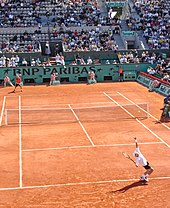Clay court (tennis)
The clay court (Engl. Clay court ) is one of four playing surfaces in tennis . It mostly consists of brick dust , a recycled product made from crushed bricks .
use
Clay courts are widespread , especially in continental European and Latin American countries, and are mostly outdoors. The most famous clay court tournament is the French Open in Paris , which has been held on this surface since 1891. The playing surface is a challenge because it is much slower than hard and grass courts. The reason for this is that the balls bounce off relatively high and thus lose speed. As a result, the games last longer on average than games on other surfaces.
Most tennis courts are made of red sand. At the Madrid Masters 2012 , tournament director Ion Țiriac introduced the blue sand. However, in the opinion of the players, this was faster and more slippery than the red sand and therefore received a lot of criticism. A year later the game was played on red sand again.
Most successful players
The Spaniard Rafael Nadal is as often Sand King (Engl. King of clay ) because he holds several records on this surface. For example, he won the French Open twelve times and the Monte Carlo Masters eleven times. He has won 57 tournaments on this surface so far.
Between 1973 and 1979, the American Chris Evert was victorious on clay 125 times in a row - a record that has never been achieved to this day. She won all of her games on this surface between August 1973 and May 1979.
See also
Individual evidence
- ↑ Discussions about the blue sand - Nadal vs. Williams
- ↑ Djokovic is also considering a Madrid boycott
- ↑ GEOFF MACDONALD: Analysis: Nadal Shows Why He Is the King of Clay . Tennis Blog of The New York Times , June 1, 2011, Retrieved May 3, 2012.
- ↑ diepresse.com: Nadal remains clay court king of Monte Carlo . Retrieved April 23, 2012.

